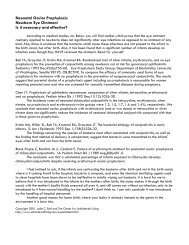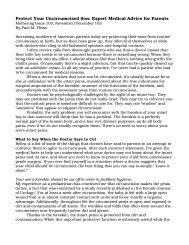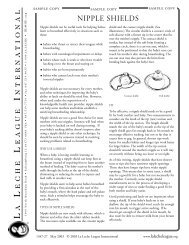The Hidden Risks of Epidurals - Balanced Birth Services
The Hidden Risks of Epidurals - Balanced Birth Services
The Hidden Risks of Epidurals - Balanced Birth Services
Create successful ePaper yourself
Turn your PDF publications into a flip-book with our unique Google optimized e-Paper software.
For the baby, instrumental delivery can increase the short-term risks <strong>of</strong> bruising, facial injury, displacement <strong>of</strong> the skull bones, andcephalohematoma (blood clot under the scalp). 24 <strong>The</strong> risk <strong>of</strong> intracranial hemorrhage (bleeding inside the brain) was increased in one study by morethan four times for babies born by forceps compared to those with spontaneous births, 25 although two studies showed no detectable developmentaldifferences for forceps-born children at five years old. 26, 27 Another study showed that when women with an epidural had a forceps delivery, theforce used by the clinician to deliver the baby was almost twice the force used when an epidural was not in place. 28<strong>Epidurals</strong> also increase the need for Pitocin to augment labor, probably due to the negative effect on the laboring woman's own release <strong>of</strong>oxytocin. Women laboring with an epidural in place are almost three times more likely to be administered Pitocin. 29 <strong>The</strong> combination <strong>of</strong> epiduralsand Pitocin, both <strong>of</strong> which can cause abnormalities in the fetal heart rate (FHR) that indicate fetal distress, markedly increases the risk <strong>of</strong> operativedelivery (forceps, vacuum, or cesarean delivery). In one Australian survey, about half <strong>of</strong> first-time mothers who were administered both an epiduraland Pitocin had an operative delivery. 30<strong>The</strong> impact <strong>of</strong> epidurals on the risk <strong>of</strong> cesarean is contentious; differing recent reviews suggest no increased risk 31 and an increase in risk<strong>of</strong> 50 percent. 32 <strong>The</strong> risk is probably most significant for women having an epidural with their first baby. 33Note that the studies used to arrive at these conclusions are mostly randomized controlled trials in which the women who agree toparticipate are randomly assigned to either epidural or nonepidural pain relief. Nonepidural pain relief usually involves the administration <strong>of</strong> opiatessuch as meperidine (aka pethidine). Many <strong>of</strong> these studies are flawed from high rates <strong>of</strong> crossover - women who were assigned to nonepidurals butwho ultimately did have epidurals, and vice versa. Also, noting that there are no true controls - that is, women who are not using any form <strong>of</strong> painrelief - these studies cannot tell us anything about the impact <strong>of</strong> epidurals compared to birth without analgesic drugs.Epidural Techniques and Side Effects<strong>The</strong> drugs used in labor epidurals are powerful enough to numb, and usually paralyze, the mother's lower body, so it is not surprising thatthere can be significant side effects for mother and baby. <strong>The</strong>se side effects range from minor to life-threatening and depend, to some extent, on thespecific drugs used.Many <strong>of</strong> the epidural side effects mentioned below are not improved with low-dose or walking epidurals, because women using thesetechniques may still receive a substantial total dose <strong>of</strong> local anesthetic, especially when continuous infusions and/or patient-controlled boluses (singlelarge doses) are used. 34 <strong>The</strong> addition <strong>of</strong> opiate drugs in epidurals or CSEs can create further risks for the mother, such as pruritus (itching) andrespiratory depression (see below).Maternal Side Effects<strong>The</strong> most common side effect <strong>of</strong> epidurals is a drop in blood pressure. This effect is almost universal and is usually preempted byadministering IV fluids before placing an epidural. Even with this "preloading," episodes <strong>of</strong> significant low blood pressure (hypotension) occur for upto half <strong>of</strong> all women laboring with an epidural, 35, 36 especially in the minutes following the administration <strong>of</strong> a drug bolus. Hypotension can causecomplications ranging from feeling faint to cardiac arrest 37 and can also affect the baby's blood supply (see below). Hypotension can be treatedwith more IV fluids and, if severe, with injections <strong>of</strong> epinephrine (adrenaline).Other common side effects <strong>of</strong> epidurals include inability to pass urine (necessitating a urinary catheter) for up to two-thirds <strong>of</strong> women; 38itching <strong>of</strong> the skin (pruritus) for up to two-thirds <strong>of</strong> women administered an opiate drug via epidural; 39, 40 shivering for up to one in three women; 41sedation for around one in five women; 42 and nausea and vomiting for one in twenty women. 43<strong>Epidurals</strong> can also cause a rise in temperature in laboring women. Fever over 100.4F (38C) during labor is five times more likely overallfor women using an epidural; 44 this rise in temperature is more common in women having their first babies, and more marked with prolongedexposure to epidurals. 45 For example, in one study, 7 percent <strong>of</strong> first-time mothers laboring with an epidural were feverish after six hours, increasingto 36 percent after 18 hours. 46 Maternal fever can have a significant effect on the baby (see below).Opiate drugs, especially administered as spinals, can cause unexpected breathing difficulties for the mother, which may come on hoursafter birth and may progress to respiratory arrest. One author comments, "Respiratory depression remains one <strong>of</strong> the most feared and leastpredictable complications <strong>of</strong> ... intrathecal [spinal] opioids." 47Many observational studies have found an association between epidural use and bleeding after birth (postpartum hemorrhage). 48-53 Forexample, a large UK study found that women were twice as likely to experience postpartum hemorrhaging when they used an epidural in labor. 54This statistic may be related to the increase in instrumental births and perineal trauma (causing bleeding), or may reflect some <strong>of</strong> the hormonaldisruptions mentioned above.An epidural gives inadequate pain relief for 10 to 15 percent <strong>of</strong> women, 55 and the epidural catheter needs to be reinserted in about 5percent. 56 For around 1 percent <strong>of</strong> women, the epidural needle punctures the dura (dural tap); this usually causes a severe headache that can lastup to six weeks, but can usually be treated by an injection into the epidural space. 57, 58More serious side effects are rare. If epidural drugs are inadvertently injected into the bloodstream, local anesthetics can cause toxiceffects such as slurred speech, drowsiness, and, at high doses, convulsions. This error occurs in around one in 2,800 epidural insertions. 59 Overall,life-threatening reactions occur for around one in 4,000 women. 60-63 Death associated with an obstetric epidural is very rare, 64 but it can be causedby cardiac or respiratory arrest, or by an epidural abscess that develops days or weeks afterward.Later complications include weakness and numbness in 4 to 18 per 10,000 women. Most <strong>of</strong> these complications resolve spontaneouslywithin three months. 65-69 Longer-term or permanent problems can arise from damage to a nerve during epidural placement; from abscess orhematoma (blood clot), which can compress the spinal cord; and from toxic reactions in the covering <strong>of</strong> the spinal cord, which can lead toparaplegia. 70Side Effects for the BabySome <strong>of</strong> the most significant and well-documented side effects for the unborn baby (fetus) and newborn derive from effects on the mother.<strong>The</strong>se include, as mentioned above, effects on her hormonal orchestration, blood pressure, and temperature regulation. As well, drug levels in thefetus and newborn may be even higher than in the mother, 71 which may cause direct toxic effects. For example, epidurals can cause changes in the
fetal heart rate (FHR) that indicate that the unborn baby is lacking blood and oxygen. This effect is well known to occur soon after theadministration <strong>of</strong> an epidural (usually within the first 30 minutes), can last for 20 minutes, and is particularly likely following the use <strong>of</strong> opiatedrugs administered via epidural and spinal. Most <strong>of</strong> these changes in FHR will resolve themselves spontaneously with a change in position. Morerarely, they may require drug treatment. 72 More severe changes, and the fetal distress they reflect, may require an urgent cesarean.Note also that the use <strong>of</strong> opiate drugs for labor analgesia can also cause FHR abnormalities. This process makes the real effects <strong>of</strong>epidurals on FHR hard to assess because, in almost all randomized trials, epidurals are compared with meperidine or other opiate drugs. Oneresearcher notes that the supine position (lying on the back) may contribute significantly to hypotension and FHR abnormalities when an epidural isin place. 73 Another found that the supine position (plus epidural) was associated with a significant decrease in the oxygen supply to the baby's brain(fetal cerebral oxygenation). 74<strong>The</strong> baby can also be affected by an epidural-induced rise in the laboring mother's temperature. In one large study <strong>of</strong> first-time mothers,babies born to febrile (feverish) mothers, 97 percent <strong>of</strong> whom had received epidurals, were more likely than babies born to afebrile mothers to be inpoor condition (low Apgar score); have poor tone; require resuscitation (11.5 percent versus 3 percent); or have seizures in the newborn period. 75One researcher noted a tenfold increase in risk <strong>of</strong> newborn encephalopathy (signs <strong>of</strong> brain damage) in babies born to febrile mothers. 76Maternal fever in labor can also directly cause problems for the newborn. Because fever can be a sign <strong>of</strong> infection involving the uterus,babies born to febrile mothers are almost always evaluated for infection (sepsis). Sepsis evaluation involves prolonged separation from the mother,admission to special care, invasive tests, and, most likely, administration <strong>of</strong> antibiotics until test results are available. In one study <strong>of</strong> first-timemothers, 34 percent <strong>of</strong> epidural babies were given a sepsis evaluation compared to 9.8 percent <strong>of</strong> nonepidural babies. 77Drugs and ToxicityEvery drug that the mother receives in labor will pass through the placenta to her baby, who is more vulnerable to toxic effects. <strong>The</strong>maximum effects are likely to be at birth and in the hours immediately after, when drug levels are highest.<strong>The</strong>re are few studies <strong>of</strong> the condition <strong>of</strong> epidural babies at birth, and almost all <strong>of</strong> these compare babies born after epidurals with babiesborn after exposure to opiate drugs, which are known to cause drowsiness and difficulty with breathing. <strong>The</strong>se studies show little differencebetween epidural and nonepidural (usually opiate-exposed) babies in terms <strong>of</strong> Apgar score and umbilical-cord pH, both <strong>of</strong> which reflect a baby'scondition at birth. 78 However, a large-population survey from Sweden found that use <strong>of</strong> an epidural was significantly associated with a low Apgarscore at birth. 79<strong>The</strong>re are also reports <strong>of</strong> newborn drug toxicity from epidural drugs, especially opiates administered via epidural. 80 Newborn opiatetoxicity seems more likely with higher dose regimes, including those where the mother is able to self-administer extra doses, although there are widedifferences in individual newborn sensitivity. 81It is important to note that a newborn baby's ability to process and excrete drugs is much less than an adult's. For example, the half-life(time to reduce drug blood levels by half) for the local anesthetic bupivacaine (Marcaine) is 8.1 hours in the newborn, compared to 2.7 hours in themother. 82 Also, drug blood levels may not accurately reflect the baby's toxic load because drugs may be taken up from the blood and stored innewborn tissues such as the brain and liver, 83 from where they are more slowly released. 84A recent review also found higher rates <strong>of</strong> jaundice for epidural-exposed babies. This result may be related to the increase in instrumentaldeliveries or to the increased use <strong>of</strong> Pitocin. 85Neurobehavioral Effects<strong>The</strong> effects <strong>of</strong> epidural drugs on newborn neurobehavior (behavior that reflects brain state) are controversial. Older studies comparingbabies exposed to epidurals with babies whose mothers received no drugs have found significant neurobehavioral effects, whereas more recentfindings from randomized controlled trials (which, as noted, compare epidural- and opiate-exposed newborns) have found no differences. However,these older studies also used the more comprehensive (and difficult to administer) Brazelton Neonatal Behavioral Assessment Score (NBAS, devisedby pediatricians), whereas more recent tests have used less complex procedures, especially the Neurologic and Adaptive Capacity Score (NACS,devised by anesthesiologists), which aggregates all data into a single figure and which has been criticized as insensitive and unreliable. 86-88For example, all three studies comparing epidural-exposed with unmedicated babies, and using the NBAS, found significant differencesbetween groups: 89Ann Murray et al. compared 15 unmedicated with 40 epidural-exposed babies and found that the epidural babies still had a depressedNBAS score at five days, with particular difficulty controlling their state. Twenty babies whose mothers had received oxytocin as well as an epiduralhad even more depression <strong>of</strong> NBAS scores, which may be explained by their higher rates <strong>of</strong> jaundice. At one month, epidural mothers found theirbabies "less adaptable, more intense and more bothersome in their behavior." <strong>The</strong>se differences could not be explained by the more difficultdeliveries and subsequent maternal-infant separations associated with epidurals. 90Carol Sepkoski et al. compared 20 epidural babies with 20 unmedicated babies, and found less alertness and ability to orient for the firstmonth <strong>of</strong> life. <strong>The</strong> epidural mothers spent less time with their babies in the hospital, in direct proportion to the total dose <strong>of</strong> bupivacaineadministered. 91 Deborah Rosenblatt et al. tested epidural babies with NBAS over six weeks and found maximal depression on the first day.Although there was some recovery, at three days epidural babies still cried more easily and more <strong>of</strong>ten; aspects <strong>of</strong> this problem ("control <strong>of</strong> state")persisted for the full six weeks. 92Although these older studies used conventional epidurals, the total dose <strong>of</strong> bupivacaine administered to the mothers (in these studies,mean doses <strong>of</strong> 61.6 mg, 93 112.7 mg, 94 and 119.8 mg, 95 respectively) was largely comparable to more recent low-dose studies (for example, 67.5mg, 96 91.1 mg, 97 and 101.1 mg 98 ).<strong>The</strong>se neurobehavioral studies highlight the possible impact <strong>of</strong> epidurals on newborns and on the evolving mother-infant relationship. Intheir conclusions, the researchers express concern about "the importance <strong>of</strong> first encounters with a disorganized baby in shaping maternalexpectations and interactive styles." 99
Animal StudiesAnimal studies suggest that the disruption <strong>of</strong> maternal hormones caused by epidurals, described above, may also contribute to maternalinfantdifficulties. Researchers who administered epidurals to laboring sheep found that the epidural ewes had difficulty bonding to their newbornlambs, especially those in first lambing with an epidural administered early in labor. 100<strong>The</strong>re are no long-term studies <strong>of</strong> the effects <strong>of</strong> epidural analgesia on exposed human <strong>of</strong>fspring. However, studies on some <strong>of</strong> our closestanimal relatives give cause for concern. M. S. Golub et al. administered epidural bupivacaine to pregnant rhesus monkeys at term and followed thedevelopment <strong>of</strong> the exposed <strong>of</strong>fspring to age 12 months (equivalent to four years in human <strong>of</strong>fspring). She found that milestone achievement wasabnormal in these monkeys: at six to eight weeks they were slow in starting to manipulate, and at ten months the increase in "motor disturbancebehaviors" that normally occurs was prolonged. 101 <strong>The</strong> author concludes, "<strong>The</strong>se effects could occur as a result <strong>of</strong> effects on vulnerable brainprocesses during a sensitive period, interference with programming <strong>of</strong> brain development by endogenous [external] agents or alteration in earlyexperiences." 102BreastfeedingAs with neurobehavior, effects on breastfeeding are poorly studied, and more recent randomized controlled trials comparing exposure toepidural and opiate drugs are especially misleading because opiates have a well-recognized negative effect on early breastfeeding behavior andsuccess. 103-107<strong>Epidurals</strong> may affect the experience and success <strong>of</strong> breastfeeding through several mechanisms. First, the epidural-exposed baby may haveneurobehavioral abnormalities caused by drug exposure that are likely to be maximal in the hours following birth - a critical time for the initiation<strong>of</strong> breastfeeding. Recent research has found (rather obviously) that the higher the newborn's neurobehavior score, the higher his or her score forbreastfeeding behavior. 108In another study, the baby's breastfeeding abilities, as measured by the Infant Breastfeeding Assessment Tool (IBFAT), were highestamong unmedicated babies, lower for babies exposed to epidurals or IV opiates, and lowest for babies exposed to both. Infants with lower scoreswere weaned earlier, although overall, similar numbers in all groups were breastfeeding at six weeks. 109 In other research, babies exposed toepidurals and spinals were more likely to lose weight in the hospital, which may reflect poor feeding efficiency. 110 Other research has suggested thatnewborn breastfeeding behavior and NACS scores may be normal when an ultra-low-dose epidural is used, although even in this study, babies withhigher drug levels had lower neurobehavior (NACS) scores at two hours. 111Second, epidurals may affect the new mother, making breastfeeding more difficult. This situation is likely if she has experienced a longlabor, an instrumental delivery, or separation from her baby, all <strong>of</strong> which are more likely following an epidural. Hormonal disruptions may alsocontribute, as oxytocin is a major hormone <strong>of</strong> breastfeeding.One study found that babies born after epidurals were less likely to be fully breastfed on hospital discharge; this was a special risk forepidural mothers whose babies did not feed in the first hour after birth. 112 A Finnish survey records that 67 percent <strong>of</strong> women who had laboredwith an epidural reported partial or full formula feeding in the first 12 weeks compared to 29 percent <strong>of</strong> nonepidural mothers; epidural motherswere also more likely to report having "not enough milk." 113Two groups <strong>of</strong> Swedish researchers have looked at the subtle but complex breastfeeding and prebreastfeeding behavior <strong>of</strong> unmedicatednewborns. One group has documented that when placed skin-to-skin on the mother's chest, a newborn can crawl up, find the nipple, and selfattach.114 Newborns affected by opiate drugs in labor or separated from their mothers briefly after birth lose much <strong>of</strong> this ability. <strong>The</strong> other Swedishgroup found that newborns exposed to labor analgesia (mostly opiates, but including some epidurals) were also disorganized in their prefeedingbehavior - nipple massage and licking, and hand sucking - compared to unmedicated newborns. 115Satisfaction with <strong>Birth</strong>Obstetric care providers have assumed that control <strong>of</strong> pain is the foremost concern <strong>of</strong> laboring women and that effective pain relief willensure a positive birth experience. In fact, there is evidence that the opposite may be true. Several studies have shown that women who use nolabor medication are the most satisfied with their birth experience at the time, 116 at six weeks, 117 and at one year after the birth. 118 In a UK survey<strong>of</strong> 1,000 women, those who had used epidurals reported the highest levels <strong>of</strong> pain relief but the lowest levels <strong>of</strong> satisfaction with the birth, probablybecause <strong>of</strong> the higher rates <strong>of</strong> intervention.Finally, it is noteworthy that caregiver preferences may to a large extent dictate the use <strong>of</strong> epidurals and other medical procedures forlaboring women. One study found that women under the care <strong>of</strong> family physicians with a low mean use <strong>of</strong> epidurals were less likely to receivemonitoring and Pitocin, to deliver by cesarean, and to have their babies admitted to newborn special care. 119Conclusion<strong>Epidurals</strong> have possible benefits but also significant risks for the laboring mother and her baby. <strong>The</strong>se risks are well documented in themedical literature but may not be disclosed to the laboring woman. Women who wish to avoid the use <strong>of</strong> epidurals are advised to choose caregiversand models <strong>of</strong> care that promote, support, and understand the principles and practice <strong>of</strong> natural and undisturbed birth.NOTES1. G. R. Hamilton and T. F. Baskett, "In the Arms <strong>of</strong> Morpheus: <strong>The</strong> Development <strong>of</strong> Morphine for Postoperative Pain Relief," Can J Anaesth 47, no. 4 (2000): 367-374.2. E. Declercq et al., Listening to Mothers: Report <strong>of</strong> the First National U.S. Survey <strong>of</strong> Women's Childbearing Experiences (New York: Maternity Center Association, October2002): 1.3. Canadian Institute for Health Information, Giving <strong>Birth</strong> in Canada: A Regional Pr<strong>of</strong>ile (Ontario: CIHA, 2004):74. National Health Service, NHS Maternity Statistics, England: 2003-04 (Crown Copyright, 2005): 6.5. E. D. Hodnett, "Pain and Women's Satisfaction with the Experience <strong>of</strong> Childbirth: A Systematic Review," Am J Obstet Gynecol 186, Supplement 5 (2002): S160-S172.6. S. J. Buckley, "Ecstatic <strong>Birth</strong>: <strong>The</strong> Hormonal Blueprint <strong>of</strong> Labor," Mothering no. 111 (March-April 2002):http://www.mothering.com/articles/pregnancy_birth/birth_preparation/ecstatic.html7. World Health Organization, Care in Normal <strong>Birth</strong>: A Practical Guide. Report <strong>of</strong> a Technical Working Group (Geneva: World Health Organization, 1996): 16.
8. V. A. Rahm et al., "Plasma Oxytocin Levels in Women During Labor With or Without Epidural Analgesia: A Prospective Study," Acta Obstet Gynecol Scand 81, no. 11(November 2002): 1033-1039.9. R. M. Stocche et al., "Effects <strong>of</strong> Intrathecal Sufentanil on Plasma Oxytocin and Cortisol Concentrations in Women During the First Stage <strong>of</strong> Labor," Reg Anesth Pain Med 26,no. 6 (November-December 2001): 545-550.10. Ibid.11. C. F. Goodfellow et al., "Oxytocin Deficiency at Delivery with Epidural Analgesia," Br J Obstet Gynaecol 90, no. 3 (March 1983): 214-219.12. O. Behrens et al., "Effects <strong>of</strong> Lumbar Epidural Analgesia on Prostaglandin F2 Alpha Release and Oxytocin Secretion During Labor," Prostaglandins 45, no. 3 (March 1993):285-296.13. M. Brinsmead et al, "Peripartum Concentrations <strong>of</strong> Beta Endorphin and Cortisol and Maternal Mood States," Aust NZ J Obstet Gynaecol 25, no. 3 (August 1985): 194-197.14. G. Bacigalupo et al., "Quantitative Relationships between Pain Intensities during Labor and Beta-endorphin and Cortisol Concentrations in Plasma. Decline <strong>of</strong> the HormoneConcentrations in the Early Postpartum Period." J Perinat Med 18, no. 4 (1990): 289-296.15. A. Costa et al., "Adrenocorticotropic Hormone and Catecholamines in Maternal, Umbilical and Neonatal Plasma in Relation to Vaginal Delivery," J Endocrinol Invest 11, no.10 (November 1988): 703-709.16. M. Odent, "<strong>The</strong> Fetus Ejection Reflex," in <strong>The</strong> Nature <strong>of</strong> <strong>Birth</strong> and Breastfeeding (Sydney: Ace Graphics, 1992): 29-43.17. R. P. Lederman et al., "Anxiety and Epinephrine in Multiparous Women in Labor: Relationship to Duration <strong>of</strong> Labor and Fetal Heart Rate Pattern," Am J Obstet Gynecol153, no. 8 (15 December 1985): 870-877.18. G. Arici et al., "<strong>The</strong> Effects <strong>of</strong> Bupivacaine, Ropivacaine and Mepivacaine on the Contractility <strong>of</strong> Rat Myometrium," Int J Obstet Anesth 13, no. 2 (April 2004): 95-98.19. B. L. Leighton and S. H. Halpern, "<strong>The</strong> Effects <strong>of</strong> Epidural Analgesia on Labor, Maternal, and Neonatal Outcomes: A Systematic Review," Am J Obstet Gynecol 186,Supplement 5 (May 2002): S69-S77.20. Ibid.21. E. Lieberman et al., "Changes in Fetal Position During Labor and their Association with Epidural Analgesia," Obstet Gynecol 105, no. 5, Part I (May 2005): 974-982.22. S. E. Ponkey et al., "Persistent Fetal Occiput Posterior Position: Obstetric Outcomes," Obstet Gynecol 101, no. 5, pt. 1 (May 2003): 915-920.23. COMET Study Group UK, "Effect <strong>of</strong> Low-Dose Mobile versus Traditional Epidural Techniques on Mode <strong>of</strong> Delivery: A Randomised Controlled Trial," <strong>The</strong> Lancet 358, no.9275 (7 July 2001): 19-23.24. J. H. Johnson et al., "Immediate Maternal and Neonatal Effects <strong>of</strong> Forceps and Vacuum-Assisted Deliveries," Obstet Gynecol 103, no. 3 (March 2004): 513-518.25. B. S. Jhawar et al., "Risk Factors for Intracranial Hemorrhage Among Full-Term Infants: A Case-Control Study," Neurosurgery 52, no. 3 (March 2003): 581-590 (discussion,588-590).26. W. G. McBride et al., "Method <strong>of</strong> Delivery and Developmental Outcome at Five Years <strong>of</strong> Age," Med J Aust 1, no. 8 (21 April 1979): 301-304.27. B. D. Wesley et al., "<strong>The</strong> Effect <strong>of</strong> Forceps Delivery on Cognitive Development," Am J Obstet Gynecol 169, no. 5 (November 1993): 1091-1095.28. S. H. Poggi et al., "Effect <strong>of</strong> Epidural Anaesthesia on Clinician-Applied Force During Vaginal Delivery," Am J Obstet Gynecol 191, no. 3 (September 2004): 903-906.29. See Note 19.30. C. L. Roberts et al., "Rates for Obstetric Intervention Among Private and Public Patients in Australia: Population Based Descriptive Study," Br Med J 321, no. 7254 (15 July2000): 137-141.31. See Note 19.32. E. Lieberman and C. O'Donoghue, "Unintended Effects <strong>of</strong> Epidural Analgesia During Labor: A Systematic Review," Am J Obstet Gynecol 186, Supplement 5 (May 2002):S31-S68.33. J. A. Thorp et al., "<strong>The</strong> Effect <strong>of</strong> Continuous Epidural Analgesia on Cesarean Section for Dystocia in Nulliparous Women," vAm J Obstet Gynecol 161, no. 3 (September1989): 670-675.34. See Note 23.35. L. M. Goetzl, "Obstetric Analgesia and Anesthesia," ACOG Practice Bulletin, Clinical Management Guidelines for Obstetrician-Gynecologists no. 36, Obstet Gynecol 100, no.1 (July 2002): 177-191.36. L. J. Mayberry et al., "Epidural Analgesia Side Effects, Co-Interventions, and Care <strong>of</strong> Women During Childbirth: A Systematic Review," Am J Obstet Gynecol 186,Supplement 5 (2002): S81-S93.37. D. B. Scott and B. M. Hibbard, "Serious Non-Fatal Complications Associated with Extradural Block in Obstetric Practice," Br J Anaesthv 64, no. 5 (May 1990): 537-541.38. See Note 36.39. See Note 35.40. See Note 36.41. D. Buggy and J. Gardiner, "<strong>The</strong> Space Blanket and Shivering During Extradural Analgesia in Labour," vActa Anaesthesiol Scand 39, no. 4 (May 1995): 551-553.42. See Note 36.43. Ibid.44. See Note 19.45. See Note 32.46. E. Lieberman et al., "Epidural Analgesia, Intrapartum Fever, and Neonatal Sepsis Evaluation," Pediatrics 99, no. 3 (March 1997): 415-419.47. P. DeBalli and T. W. Breen, "Intrathecal Opioids for Combined Spinal-Epidural Analgesia During Labour," CNS Drugs 17, no. 12 (2003): 889-904 (892-893).48. N. S. Saunders et al., "Neonatal and Maternal Morbidity in Relation to the Length <strong>of</strong> the Second Stage <strong>of</strong> Labour," Br J Obstet Gynaecol 99, no. 5 (May 1992): 381-385.49. L. St. George and A. J. Crandon, "Immediate Postpartum Complications," Aust NZ J Obstet Gynaecol 30, no. 1 (February 1990): 52-56.50.. E. F. Magann et al., "Postpartum Hemorrhage after Vaginal <strong>Birth</strong>: An Analysis <strong>of</strong> Risk Factors," South Med J 98, no. 4 (April 2005): 419-422.51. T. M. Eggebo and L. K. Gjessing, ["Hemorrhage After Vaginal Delivery"], Tidsskr Nor Laegeforen 120, no. 24 (10 October 2000): 2860-2863.52>. B. Ploeckinger et al., "Epidural Anaesthesia in Labour: Influence on Surgical Delivery Rates, Intrapartum Fever and Blood Loss," Gynecol Obstet Invest 39, no. 1 (1995): 24-27.53. L. Gilbert et al., "Postpartum Haemorrhage: A Continuing Problem," Br J Obstet Gynaecol 94, no. 1 (January 1987): 67-71.54. See Note 48.55. See Note 35.56.M. J. Paech et al., "Complications <strong>of</strong> Obstetric Epidural Analgesia and Anaesthesia: A Prospective Analysis <strong>of</strong> 10,995 Cases," Int J Obstet Anesth 7, no. 1 (January 1998): 5-11.57. P. C. Stride and G. M. Cooper, "Dural Taps Revisited: A 20-Year Survey from Birmingham Maternity Hospital," Anaesthesia 48, no. 3 (March 1993): 247-255.58. S. N. Costigan and J. S. Sprigge, "Dural Puncture: <strong>The</strong> Patients' Perspective. A Patient Survey <strong>of</strong> Cases at a DGH Maternity Unit 1983-1993," Acta Anaesthesiol Scand 40,no. 6 (July 1996): 710-714.59.. See Note 56.60. See Note 37.61. See Note 56.62. D. B. Scott and M. E. Tunstall, "Serious Complications Associated with Epidural/Spinal Blockade in Obstetrics: A Two-Year Prospective Study," Int J Obstet Anesth 4, no. 3(July 1995): 133-139.63. J. S. Crawford, "Some Maternal Complications <strong>of</strong> Epidural Analgesia for Labour," Anaesthesia 40, no. 12 (December 1985): 1219-1225.64. F. Reynolds, "Epidural Analgesia in Obstetrics," Br Med J 299, no. 6702 (September 1989): 751-752.65. See Note 37.
66. See Note 62.67. See Note 63.68. See Note 64.69. MIDIRS and the NHS Centre for Reviews and Dissemination, "Epidural Pain Relief During Labour," in Informed Choice for Pr<strong>of</strong>essionals (Bristol: MIDIRS, 1999): 5.70. See Note 37.71. R. Fernando et al., "Neonatal Welfare and Placental Transfer <strong>of</strong> Fentanyl and Bupivacaine During Ambulatory Combined Spinal Epidural Analgesia for Labour," Anaesthesia52, no. 6 (June 1997): 517-524.72. J. Littleford, "Effects on the Fetus and Newborn <strong>of</strong> Maternal Analgesia and Anesthesia: A Review," Can J Anaesth51, no. 6 (June-July 2004): 586-609.73. G. Capogna, "Effect <strong>of</strong> Epidural Analgesia on the Fetal Heart Rate," Eur J Obstet Gynecol Reprod Biol 98, no. 2 (October 2001): 160-164.74. C. J. Aldrich et al., "<strong>The</strong> Effect <strong>of</strong> Maternal Posture on Fetal Cerebral Oxygenation During Labour," Br J Obstet Gynaecol 102, no. 1 (January 1995): 14-19.75. E. Lieberman et al., "Intrapartum Maternal Fever and Neonatal Outcome," Pediatrics 105, no. 1, pt. 1 (January 2000): 8-13.76. L. Impey et al., "Fever in Labour and Neonatal Encephalopathy: A Prospective Cohort Study," Br J Obstet Gynaecol 108, no. 6 (June 2001): 594-597.77. See Note 32.78. Ibid.79. K. Thorngren-Jerneck and A. Herbst, "Low 5-Minute Apgar Score: A Population-Based Register Study <strong>of</strong> 1 Million Term <strong>Birth</strong>s," Obstet Gynecol 98, no. 1 (2001): 65-70.80. M. Kumar and B. Paes, "Epidural Opioid Analgesia and Neonatal Respiratory Depression," J Perinatol 23, no. 5 (July-August 2003): 425-427.81. Ibid.82. T. Hale, Medications and Mothers' Milk (Amarillo, TX: Pharmas<strong>of</strong>t, 1997): 76.83. See Note 71.84. T. Hale, "<strong>The</strong> Effects on Breastfeeding Women <strong>of</strong> Anaesthetic Medications Used During Labour," <strong>The</strong> Passage to Motherhood Conference, Brisbane, Australia (1998).85. See Note 32.86. W. Camann and T. B. Brazelton, "Use and Abuse <strong>of</strong> Neonatal Neurobehavioral Testing," Anesthesiology 92, no. 1 (January 2000): 3-5.87. R. Gaiser, "Neonatal Effects <strong>of</strong> Labor Analgesia," Int Anesthesiol Clin 40, no. 4 (Fall 2002): 49-65.88. S. H. Halpern et al., "<strong>The</strong> Neurologic and Adaptive Capacity Score Is Not a Reliable Method <strong>of</strong> Newborn Evaluation," Anesthesiology 94, no. 6 (June 2001): 958-962.89. See Note 32.90. A. D. Murray et al., "Effects <strong>of</strong> Epidural Anesthesia on Newborns and their Mothers," Child Dev 52, no. 1 (March 1981): 71-82.91. C. M. Sepkoski et al., "<strong>The</strong> Effects <strong>of</strong> Maternal Epidural Anesthesia on Neonatal Behavior During the First Month," Dev Med Child Neurol 34, no. 12 (December 1992):1072-1080.92. D. B. Rosenblatt et al., "<strong>The</strong> Influence <strong>of</strong> Maternal Analgesia on Neonatal Behaviour: II. Epidural Bupivacaine," Br J Obstet Gynaecol 88, no. 4 (April 1981): 407-413.93. See Note 90.94. See Note 91.95. See Note 92.96. See Note 71.97. J. R. L<strong>of</strong>tus et al., "Placental Transfer and Neonatal Effects <strong>of</strong> Epidural Sufentanil and Fentanyl Administered with Bupivacaine During Labor," Anesthesiology 83, no. 3(1995): 300-308.98. See Note 23.99. See Note 90: 71.100. D. Krehbiel et al., "Peridural Anesthesia Disturbs Maternal Behavior in Primiparous and Multiparous Parturient Ewes," Physiol Behav 40, no. 4 (1987): 463-472.101. M. S. Golub and S. L. Germann, "Perinatal Bupivacaine and Infant Behavior in Rhesus Monkeys," Neurotoxicol Teratol 20, no. 1 (January-February 1998): 29-41.102. M. S. Golub, "Labor Analgesia and Infant Brain Development," Pharmacol Biochem Behav 55, no. 4 (1996): 619-628 (619).103. L. Righard and M. O. Alade, "Effect <strong>of</strong> Delivery Room Routines on Success <strong>of</strong> First Breast-Feed," <strong>The</strong> Lancet 336, no. 8723 (November 1990): 1105-1107.104. M. K. Matthews, "<strong>The</strong> Relationship Between Maternal Labour Analgesia and Delay in the Initiation <strong>of</strong> Breastfeeding in Healthy Neonates in the Early Neonatal Period,"Midwifery 5, no. 1 (March 1989): 3-10.105. A. B. Ransjo-Arvidson et al., "Maternal Analgesia During Labor Disturbs Newborn Behavior: Effects on Breastfeeding, Temperature, and Crying," <strong>Birth</strong> 28, no. 1 (March2001): 5-12.106. E. Nissen et al., "Effects <strong>of</strong> Maternal Pethidine on Infants' Developing Breast Feeding Behaviour," Acta Paediatr 84, no. 2 (February 1995): 140-145.107. L. Rajan, "<strong>The</strong> Impact <strong>of</strong> Obstetric Procedures and Analgesia/Anaesthesia During Labour and Delivery on Breast Feeding," Midwifery 10, no. 2 (June 1994): 87-103.108. S. Radzyminski, "Neurobehavioral Functioning and Breastfeeding Behavior in the Newborn," J Obstet Gynecol Neonatal Nurs 34, no. 3 (May-June 2005): 335-341.109. J. Riordan et al., "<strong>The</strong> Effect <strong>of</strong> Labor Pain Relief Medication on Neonatal Suckling and Breastfeeding Duration," J Hum Lact 16, no. 1 (February 2000): 7-12.110. K. G. Dewey et al., "Risk Factors for Suboptimal Infant Breastfeeding Behavior, Delayed Onset <strong>of</strong> Lactation, and Excess Neonatal Weight Loss," Pediatrics 112, no. 3, pt. 1(September 2003): 607-619.111. S. Radzyminski, "<strong>The</strong> Effect <strong>of</strong> Ultra Low Dose Epidural Analgesia on Newborn Breastfeeding Behaviors," J Obstet Gynecol Neonatal Nurs 32, no. 3 (May-June 2003): 322-331.112. D. J. Baumgarder et al., "Effect <strong>of</strong> Labor Epidural Anesthesia on Breast-Feeding <strong>of</strong> Healthy Full-Term Newborns Delivered Vaginally," J Am Board Fam Pract 16, no. 1(January-February 2003): 7-13.113. P. Volmanen et al., "Breast-Feeding Problems After Epidural Analgesia for Labour: A Retrospective Cohort Study <strong>of</strong> Pain, Obstetrical Procedures and Breast-FeedingPractices," Int J Obstet Anesth 13, no. 1 (2004): 25-29.114. See Note 103.115. See Note 105.116. S. Kannan et al., "Maternal Satisfaction and Pain Control in Women Electing Natural Childbirth," Reg Anesth Pain Medvv 26, no. 5 (September-October 2001): 468-472.117. J. M. Green et al., "Expectations, Experiences, and Psychological Outcomes <strong>of</strong> Childbirth: A Prospective Study <strong>of</strong> 825 Women," <strong>Birth</strong> 17, no. 1 (March 1990): 15-24.118. B. M. Morgan et al., "Analgesia and Satisfaction in Childbirth (<strong>The</strong> Queen Charlotte's 1000 Mother Survey)," <strong>The</strong> Lancet 2, no. 8302 (9 October 1982): 808-810.119. M. C. Klein et al., "Epidural Analgesia Use as a Marker for Physician Approach to <strong>Birth</strong>: Implications for Maternal and Newborn Outcomes," <strong>Birth</strong> 28, no. 4 (December2001): 243-248.Sarah J. Buckley is a family physician, an internationally published writer, and a full-time mother to Emma, Zoe, Jacob, and Maia Rose, all born at home. She is theauthor <strong>of</strong> Gentle <strong>Birth</strong>, Gentle Mothering: <strong>The</strong> wisdom and science <strong>of</strong> gentle choices in pregnancy, birth, and parenting, published in early 2006. To read more fromSarah J. Buckley, and to order her book, visit www.sarahjbuckley.com.











